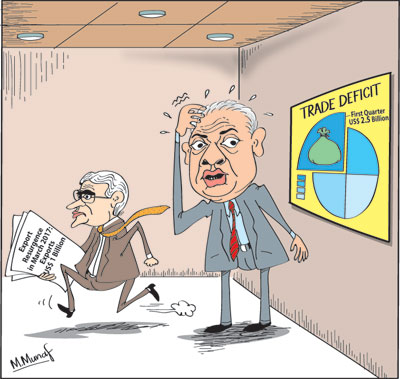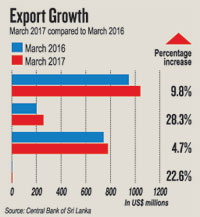Columns
Despite massive trade deficit in first quarter increased exports in March lend hope of an export recovery
View(s):The trade deficit reached a massive US$2.5 billion in the first three months of the year. If the trade performance continues in this way, this year’s trade deficit could exceed US$10 billion. However there are expectations that the trade deficit could be brought down owing to an expected increase in exports and reduction in some key imports.
 With a surge in exports in March, there is an expectation of an export growth in the remaining nine months that could ease the trade balance. Exports have performed well in April too. The possibility of containing the trade gap during the course of the year is due to this expectation of increased exports and possibilities of containing some major imports, particularly fuel, during the remaining months of the year. It is essential to bring down this year’s trade deficit to below US$9 billion.
With a surge in exports in March, there is an expectation of an export growth in the remaining nine months that could ease the trade balance. Exports have performed well in April too. The possibility of containing the trade gap during the course of the year is due to this expectation of increased exports and possibilities of containing some major imports, particularly fuel, during the remaining months of the year. It is essential to bring down this year’s trade deficit to below US$9 billion.
Trade deficits
Large trade deficits have been a serious economic concern in recent years. They have weakened the external finances of the country and contributed towards balance of payments crises. The inability to contain imports when exports were faring badly resulted in massive trade deficits of US$8.3 billion in 2004, US$8.4 billion in 2015 and US$9.1 billion last year.
Imports have been much higher than export earnings for many years. This inability to contain imports when exports were falling resulted in trade deficits increasing in the last three years. In the first three months of this year too, it was the substantial increase in imports that caused the large trade deficit.
First quarter
The further deterioration in the trade deficit to as much as US$2.5 billion in the first quarter of this year is disturbing. During the first quarter of this year, the trade deficit widened further owing to the increase in imports by 15 percent, whereas the increase in exports was only 1.3 percent. Despite an improvement in exports in March 2017, this increase in export earnings was offset by the higher increase in import expenditure. Nevertheless the surge in exports in March this year to over US$1 billion lends hope to an improvement in the trade balance this year.
 In the first quarter of this year the trade deficit increased to a massive US$2.5 billion compared to US$1.86 billion in the first three months of last year. All three categories of imports increased with intermediate imports increasing by nearly 20 percent. On the other hand, manufactured exports declined by 2.7 percent, while agricultural exports increased 16.7 percent. Total exports increased by only 1.3 percent. The trade deficit widened by as much as 35 percent in the first quarter of this year to reach a massive US$2.5 billion.
In the first quarter of this year the trade deficit increased to a massive US$2.5 billion compared to US$1.86 billion in the first three months of last year. All three categories of imports increased with intermediate imports increasing by nearly 20 percent. On the other hand, manufactured exports declined by 2.7 percent, while agricultural exports increased 16.7 percent. Total exports increased by only 1.3 percent. The trade deficit widened by as much as 35 percent in the first quarter of this year to reach a massive US$2.5 billion.
Imports
The increase in imports by 19.4 percent in the first quarter of this year is an unprecedented rise. Imports of US$5.28 billion, if not contained could increase imports to above US$20 billion. While all categories of imports have increased, the highest increase has been in Intermediate imports. This year’s increased imports have been mainly due to an 82 percent increase in fuel imports caused mainly by drought conditions. Food and transport equipment imports have also risen.
 Exports
Exports
The declining trend in exports in recent years has been a serious concern as it is one of the primary reasons for the country’s balance of payments difficulties. In the last two years (2015 and 2016) exports declined significantly. In 2015, export earnings fell by 5.6 percent to US$10.5 billion and it declined a further 2.2 percent in 2016 to US$10.3 billion.
In January and February of this year there were further decreases in exports. In January exports fell by 1.1 percent and in February they declined by 2.7 percent to US$868 million. In contrast exports increased significantly in March this year by nearly 10 percent.
March export surge
There was a reversal of the trend of declining exports in March this year with exports increased by 2.7 percent. Reversing the declining trend observed during the last two months, earnings from exports increased by 9.8 per cent compared to March 2016. Export earnings increased to US$ 1042 million in March 2017. Agricultural as well as manufactured exports have increased significantly. This export growth has continued in April too.
Remittances and tourist earnings
The balance of payments has had two setbacks in the first quarter of this year that would hopefully be reversed. Remittances have decreased by 3.3 percent to US$1.7 billion from US$ 1.8 billion in the first quarter of last year. This is the first time in recent years when remittances have not increased.
The recent high growth in tourist earnings decelerated in the first quarter. Tourist earnings increased by only 3.4 percent in the first quarter compared to the same period of last year. Both these may revive somewhat during the rest of the year. This is especially so with respect to tourist earnings as regular flights have recommenced after the repairs to the runway at Katunayake. The geopolitical factors affecting labour in the Middle East remains a grave uncertainty.
Expectation
Despite the deterioration in the trade balance in the first quarter of the year, there is an expectation that an increase in export earnings and a reduction in intermediate and consumer goods imports would result in a trade balance of below US$9 billion. With the favourable trade developments there could be a more substantial improvement in the trade balance in 2018. However global uncertainties remain.
Concluding reflections
Although there was a significant widening of the trade deficit in the first quarter of this year, the surge in exports in March lends hope to an expectation of a much improved export performance in the remaining nine months. If exports increase to US$10 billion by the end of the year, there is a possibility of containing the trade deficit to around US$8.5 billion. This also requires a containment of import expenditure as well. With the rains experienced in May June, the reservoirs have had enough water levels for a much higher amount of hydroelectricity generation. This would reduce fuel imports and ease import expenditure. Nevertheless the growth in imports requires policy measures to contain them.


Leave a Reply
Post Comment